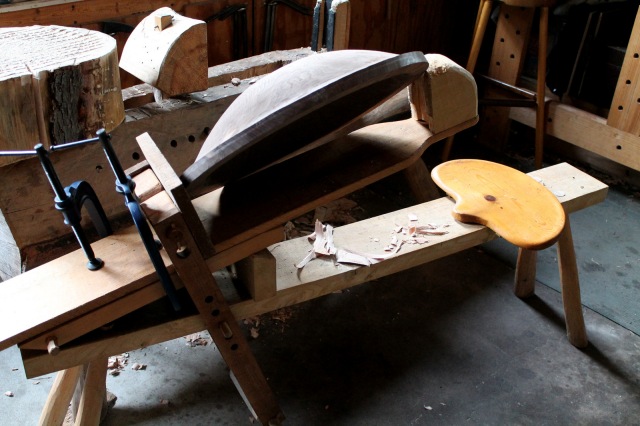
I was rooting around in the basement last weekend, and came upon a blast from the past: an attachment for my English-style shaving horse. It was the beginning of the idea that ultimately resulted in my bowl horse. Since writing the article, I’ve enjoyed hearing from others that have built their own bowl horses, either directly from the plans or some modified version. I really like using the bowl horse, but it is only beneficial for some operations. Some may not want to go to the trouble of building one, or may not have the room.
When I saw that old board, I thought it might be useful to share how I used it before building my more specialized bowl horse. Granted, the real bowl horse works better, but I made quite a few bowls with the original adaptation, and it only takes a half hour to make and doesn’t take up much room. So, if you’ve already got a shaving horse, you may be able to adapt it along these lines.

This is the shaving horse I built years ago based on plans from Jennie Alexander. It’s a very simple design, and still works well on the occasions I make a chair or something.

A couple clamps and a board are all I used to convert it into a horse that could hold a bowl from end-to-end. A thicker board, and/or a heavier horse, would improve solidity.
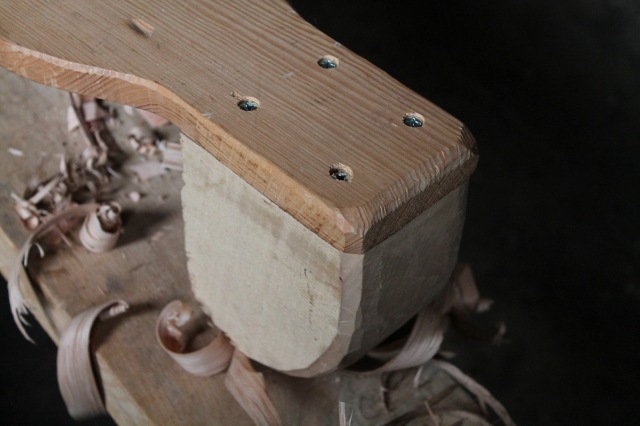
I just shaped a block of wood and attached it with screws. The block of wood could easily be replaced by a vertical upright supported by a brace behind it.

The swing arm now forces the bowl against the end block, holding it place for work with the drawknife or spokeshave.

Temporarily screwing a board onto the arm assembly is a simple option that increases the surface area of the far jaw.

Adjust for any size bowl by loosening the clamps and sliding the board.
It is nice to have a variety of holding options in terms of benches and accessories in the workshop, especially if one is making many different bowl designs. Still, while I had the shaving horse out, I thought about how I might be able to simply adapt the English shaving horse in additional ways for bowl work.
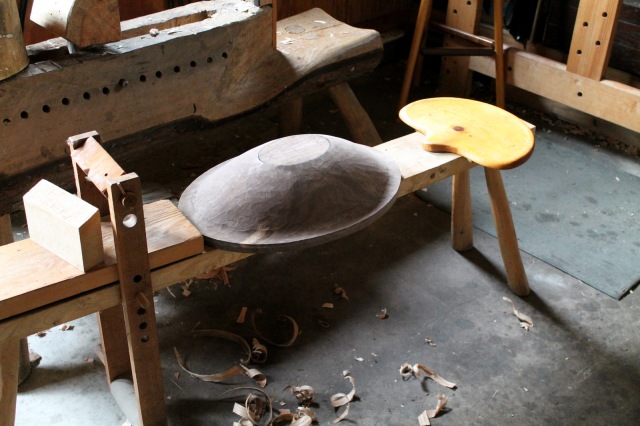
Simply dropping the support table creates a stop. Sitting astride the bowl like this could allow certain operations to be done.
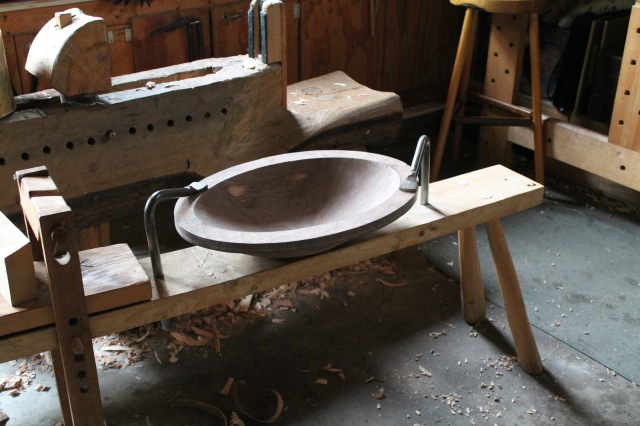
Boring a few 3/4″ holes along the length of the bench allows for the use of holdfasts.

The holes can also be used for pegs and wedges. Adze work could be done in this position, but would be more ideal if the bench were a little wider and beefier.
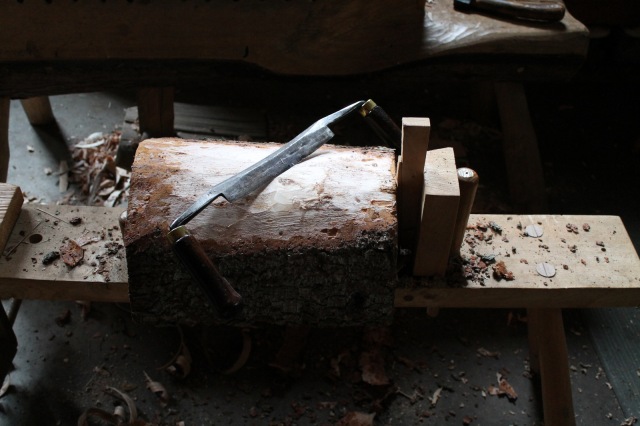
While sitting at the back of the bench, work with the drawknife was reasonably comfortable.
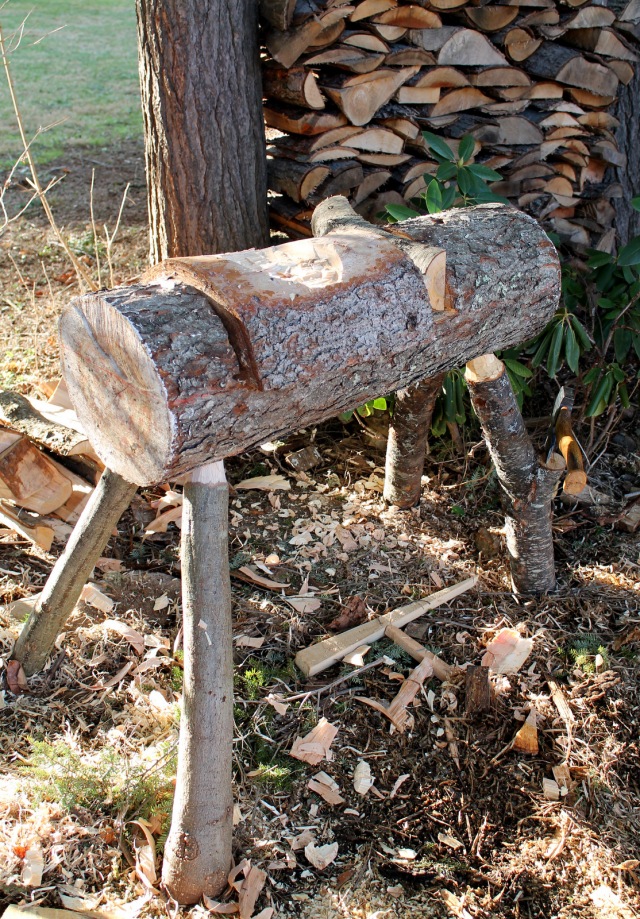
And it was such a nice winter weekend, I knocked together one of these. I’ve seen different versions of this concept in photos, including Robin Wood’s BowlMate. Should make it nice to do some roughing outside without lugging benches out of the shop.

Wow, great! You are so full of good ideas, and it is very nice that you share them! Your conversion from a shaving horse to a bowl horse is simply brilliant. I love ideas that are straightforward enough that you say ‘why didn’t I think of that?’ 🙂
Is that a new bowl in the making? (walnut?).
LikeLike
Yep, Rudy, that’s a walnut one. Several bowls underway in various stages now.
LikeLike
I’ve heard from a reader that can’t see the photos on my last two posts. He’s using Safari browser. Anybody else experiencing this or have suggestions? That stuff is beyond me — I just look to see if the squirrel is still running inside the computer.
LikeLike
Just to add a data point – I’m on Chrome and have no trouble seeing any pictures.
LikeLike
I’m using Safari (on an Ipad) and everything loads for me, just fyi. Perhaps they need to update their browser, or clear their cache (under settings).
LikeLike
I was just getting started on making a bowl horse when this popped up. My primary interest is with spoons, with possibly an occasional bowl attempt at some point in the future. Your shave horse adaptations make me wonder if I should rethink that direction. After using all versions, what would you say is most user friendly and multi-functional for spoons?
LikeLike
Jen, I don’t really use any kind of a horse much for spoons — normally going from the axe to the sloyd knife. You can use the bowl horse (with a support under the spoon) and a drawknife, but you can also adapt a traditional shaving horse for use with spoons, probably something involving a narrower work support. In your situation, if you want a horse, I’d probably recommend a traditional horse. You could adapt it a little for spoons and possibly make the adaptation from the article for an occasional bowl.
LikeLiked by 1 person
David,
Just wanted to say how much I enjoy receiving and reading your blog. I have not done any bowl carving, but am very keen to have a go. So many thanks for your generous information and the great videos etc. Really good and much appreciated.
Regards
Peter Skrzypczak (Skripjack)
Sent from Windows Mail
LikeLike
Thanks very much, Peter. If you have any questions as you get started, don’t hesitate to ask.
LikeLike
When and where is your next class???
LikeLike
Probably not until Summer of ’17. I’ll keep you posted when I know more for sure.
LikeLiked by 1 person
Thank you. This was useful, clear and achievable.
LikeLike
I needed to send you the very small note to help say thanks a lot again relating to the incredible tips you’ve shown here. This is simply surprisingly open-handed of you to make extensively all that many of us could have made available as an e-book to get some dough for themselves, especially given that you might well have done it if you considered necessary. These good ideas additionally served as the great way to be certain that other individuals have a similar dream like my very own to understand more and more concerning this matter. I’m certain there are millions of more pleasant instances in the future for folks who start reading your blog post.
LikeLiked by 1 person
Pingback: Catching up with the Bowl Horse | David Fisher, Carving Explorations
I’ve been looking for a shave horse design that will allow me to do chair parts and bowls and this fits the bill. I have limited shop space. Would there be a downside to building this out of pressure treated and leaving it outside?
LikeLike
I don’t see any problem with that at all. Pressure treated lumber is usually southern yellow pine, in my experience, so it would be plenty strong as well as durable. Happy carving!
LikeLike